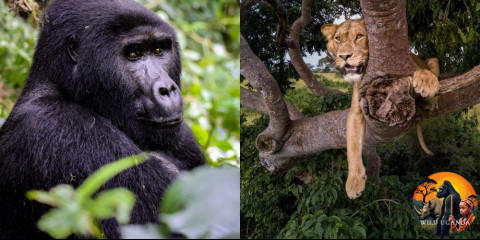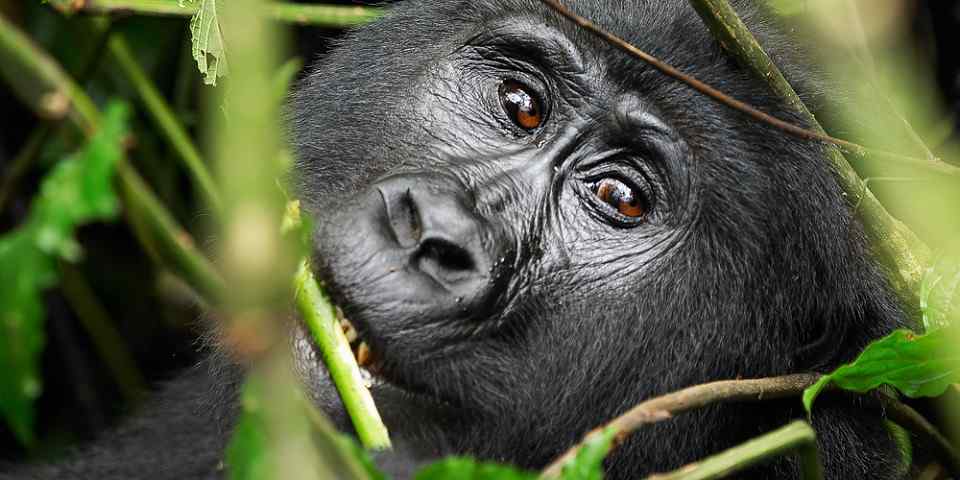Tour Length
Rates in USD $ – Change Currency
Per person, excl. international flightsOperator Rating
Other Tour Features
Filter by Operator
Filter by Accommodation
Chimp Trekking Tours
A chimpanzee trekking safari offers a special opportunity to see our closest relatives at close range. Although it doesn’t get the same attention as gorilla trekking, the experience can be quite similar. The intelligence and social structure of chimps make them fascinating subjects for observation, and no two visits are the same. Chimpanzees live in communities ranging from 20 to 150 individuals. Like humans, they tend to have strong personalities. Their expressive faces make their identities easily recognized by us, even during a short visit. Lucky visitors will be able to hear their pant-hooting. This communal, loud calling session can be triggered by anything that excites them – including you.
-

8-Day Gorillas, Chimps and Savannah Wildlife Safari
$2,145 pp (USD)
Uganda: Private tour
Mid-range Lodge & HotelYou Visit: Entebbe (Start), Bwindi Impenetrable NP (Gorillas), Queen Elizabeth NP, Kyambura Gorge (Chimps), Lake Mburo NP, Entebbe Airport (End)

Lush Africa Safaris
4.7/5 – 56 Reviews
-
Best Seller

11-Day Best of Uganda Gorillas, Chimps & Wildlife Safari
$3,890 pp (USD)
Uganda: Private tour
Mid-range Lodge & Guest HouseYou Visit: Entebbe (Start), Lake Mburo NP, Bwindi Impenetrable NP (Gorillas), Queen Elizabeth NP, Kazinga Channel (Queen Elizabeth NP), Kibale NP (Chimps), Murchison Falls NP, Entebbe Airport (End)

Kajie Safaris
5.0/5 – 179 Reviews
-

10-Day Gorilla, Chimpanzee & Big 5 Game Safari in Uganda
$3,410 pp (USD)
Uganda: Private tour
Mid-range Lodge & Guest HouseYou Visit: Entebbe (Start), Mabamba Swamp, Ziwa Rhino Ranch, Murchison Falls NP, Kibale NP (Chimps), Kalinzu FR (Chimps), Ishasha Sector (Queen Elizabeth NP), Bwindi Impenetrable NP (Gorillas), Lake Bunyonyi, Lake Mburo NP, Entebbe (End)

Wild Uganda
5.0/5 – 32 Reviews
-

10-Day Holiday Safari with Gorillas, Chimps and Wildlife
$3,300 pp (USD)
Uganda: Shared tour (max 6 people per vehicle)
Mid-range LodgeYou Visit: Entebbe (Start), Murchison Falls NP, Kibale NP (Chimps), Queen Elizabeth NP, Bwindi Impenetrable NP (Gorillas), Lake Mburo NP, Entebbe Airport (Entebbe), Kampala (End)
_1518729865.gif)
Buyaga Safaris
4.9/5 – 130 Reviews
-
Top Rated Operator
![5-Day Nyungwe Chimpanzee Trek with Lake Kivu Experiences]()
5-Day Nyungwe Chimpanzee Trek with Lake Kivu Experiences
$1,933 pp (USD)
Rwanda: Private tour
Mid-range HotelYou Visit: Kigali (Start), Nyungwe NP (Chimps), Lake Kivu, Kigali Airport (End)

Hermosa Life Tours and Travel
5.0/5 – 211 Reviews
-
![8-Day Gorilla Trekking, Chimpanzees and Africa's Big 5]()
8-Day Gorilla Trekking, Chimpanzees and Africa's Big 5
$3,487 pp (USD)
Uganda: Private tour
Mid-range Lodge & ResortYou Visit: Entebbe (Start), Murchison Falls NP, Kibale NP (Chimps), Queen Elizabeth NP, Bwindi Impenetrable NP (Gorillas), Lake Bunyonyi, Entebbe Airport (End)

Nature Connect Safaris Uganda
5.0/5 – 65 Reviews
-
Best Seller
![7-Day Highlights of Rwanda]()
7-Day Highlights of Rwanda
$9,299 pp (USD)
Rwanda: Private tour
Mid-range Lodge & HotelYou Visit: Kigali (Start), Nyungwe NP (Chimps), Lake Kivu, Volcanoes NP (Gorillas), Kigali (End)

Wayfairer Travel
5.0/5 – 202 Reviews
-
![4-Day Trekking Home of Chimpanzee]()
4-Day Trekking Home of Chimpanzee
$1,759 pp (USD)
Tanzania: Private tour
Mid-range Tented Camp & HotelYou Visit: Arusha (Start), Gombe NP, Kigoma (Town), Dar Es Salaam (End)

See Endless Adventures Tanzania
5.0/5 – 88 Reviews
-
![3-Day Gombe Chimpanzee Trekking from Dar Es Salaam]()
3-Day Gombe Chimpanzee Trekking from Dar Es Salaam
$1,474 pp (USD)
Tanzania: Private tour
Mid-range Tented Camp & HotelYou Visit: Dar Es Salaam (Start), Gombe NP, Dar Es Salaam (End)

Akondo Adventures
4.9/5 – 146 Reviews
-
![3-Day Gombe Chimpanzee Trekking from Dar Es Salaam Tour]()
3-Day Gombe Chimpanzee Trekking from Dar Es Salaam Tour
$1,428 pp (USD)
Tanzania: Private tour
Mid-range Tented Camp & HotelYou Visit: Dar Es Salaam (Start), Gombe NP, Dar Es Salaam (End)

Fondness Vacations
5.0/5 – 70 Reviews
-
![3-Day Express Gorilla and Chimpanzee Tour]()
3-Day Express Gorilla and Chimpanzee Tour
$1,920 pp (USD)
Rwanda & Uganda: Private tour
Mid-range LodgeYou Visit: Kigali (Start), Queen Elizabeth NP, Kalinzu FR (Chimps), Bwindi Impenetrable NP (Gorillas), Kigali (End)

Safari Vacations and Travel Services
5.0/5 – 35 Reviews
-
![4-Day Gorilla + Chimpanzee Treks Safari & Lake Bunyonyi]()
4-Day Gorilla + Chimpanzee Treks Safari & Lake Bunyonyi
$1,991 pp (USD)
Uganda: Shared tour (max 3 people per group)
Mid-range Lodge & ResortYou Visit: Entebbe (Start), Kibale NP (Chimps), Bwindi Impenetrable NP (Gorillas), Lake Bunyonyi, Entebbe (City), Kampala (End)

Epic Uganda Vacation
5.0/5 – 49 Reviews
-
![6-Day Rwanda Wildlife & Primates Safari Adventure]()
6-Day Rwanda Wildlife & Primates Safari Adventure
$4,045 pp (USD)
Rwanda: Shared tour (max 6 people per vehicle)BudgetLodge & Hotel
You Visit: Kigali (Start), Akagera NP, Nyungwe NP (Chimps), Volcanoes NP (Gorillas), Kigali (End)

East Africa Safari Tours
5.0/5 – 21 Reviews
-
![7-Day Bwindi, Kibale & Queen Elizabeth NP Mid-Range Tour]()
7-Day Bwindi, Kibale & Queen Elizabeth NP Mid-Range Tour
$3,058 pp (USD)
Uganda: Private tour
Mid-range Lodge & Guest HouseYou Visit: Kampala (Start), Kibale NP (Chimps), Queen Elizabeth NP, Kazinga Channel (Queen Elizabeth NP), Bwindi Impenetrable NP (Gorillas), Kampala (End)

Bugoli Adventures
5.0/5 – 20 Reviews
-
![3-Day Chimpanzee Trekking Safari in Kibale]()
3-Day Chimpanzee Trekking Safari in Kibale
$1,065 pp (USD)
Uganda: Private tour
Mid-range Tented CampYou Visit: Entebbe (Start), Kibale NP (Chimps), Entebbe Airport (End)

Kafu Safaris
5.0/5 – 17 Reviews
-
![18-Day Uganda Birding, Gorilla, Chimpanzee & Wildlife]()
18-Day Uganda Birding, Gorilla, Chimpanzee & Wildlife
$9,976 pp (USD)
Uganda: Private tourBudgetLodge & Tented Camp
You Visit: Entebbe (Start), Mabamba Swamp, Mabira FR, Mt Elgon, Mount Elgon NP, Pian Upe WR, Kidepo Valley NP, Murchison Falls NP, Kibale NP (Chimps), Bwindi Impenetrable NP (Gorillas), Lake Bunyonyi, Entebbe (End)

Jerodi Africa Safari
4.9/5 – 13 Reviews
-
![10-Day Mid Luxury Uganda Gorilla and Wildlife Safari]()
10-Day Mid Luxury Uganda Gorilla and Wildlife Safari
$5,390 to $5,445 pp (USD)
Uganda: Private tour
Mid-range Lodge & HotelYou Visit: Entebbe (Start), Murchison Falls NP, Kibale NP (Chimps), Queen Elizabeth NP, Bwindi Impenetrable NP (Gorillas), Entebbe (End)

Ganyana Safaris Uganda
4.6/5 – 35 Reviews
-
![4-Day Gorilla and Chimpanzee Flying Safari in Uganda]()
4-Day Gorilla and Chimpanzee Flying Safari in Uganda
$2,750 pp (USD)
Uganda: Private tour
Mid-range LodgeYou Visit: Entebbe (Start), Kyambura Gorge (Chimps), Bwindi Impenetrable NP (Gorillas), Entebbe Airport (End)

Myler Africa Safaris
4.9/5 – 18 Reviews
-
![4-Day Gorillas & Chimps Luxury]()
4-Day Gorillas & Chimps Luxury
$2,946 pp (USD)
Uganda: Private tourLuxuryLodge
You Visit: Entebbe (Start), Kibale NP (Chimps), Bwindi Impenetrable NP (Gorillas), Entebbe Airport (End)

The Shuttle Hospitality
5.0/5 – 17 Reviews
-
![5-Day Chimpanzee and Gorilla Safari]()
5-Day Chimpanzee and Gorilla Safari
$2,310 pp (USD)
Uganda: Private tourBudgetLodge & Resort
You Visit: Entebbe (Start), Kibale NP (Chimps), Bwindi Impenetrable NP (Gorillas), Lake Bunyonyi, Entebbe (End)

Naleyo Tours and Travels
5.0/5 – 6 Reviews
6 Questions About Chimp Trekking Tours

Answered by
Ariadne van Zandbergen
Ariadne is a renowned African wildlife photographer whose work is featured in many well-known guidebooks and magazines. She recommends chimp trekking at least twice during a safari. This is because experiences vary, and it will increase your chances of having a very special encounter with chimpanzees.› More about Ariadne
6 Questions About Chimp Trekking Tours
 Ariadne van Zandbergen
Ariadne van Zandbergen
1. Why should I choose a chimp trekking safari?
“Chimpanzee trekking is totally different from the usual safari experience. As chimpanzees live in rainforest, the only access is by foot. Chimp trekking is active and usually requires hiking for several hours to see chimps up close. Watching these great apes up close on foot is an amazing experience, almost on a par with gorilla trekking. Most African safaris are centered on car-based wildlife viewing, and activities such as chimp trekking offer a nice break from time sitting in vehicles. Chimp trekking is mostly done as part of a longer tour that includes other activities, such as wildlife viewing in savannah reserves and gorilla trekking.”
1Which countries offer chimpanzee trekking tours?
“Chimp trekking can be done in several African countries. Chimpanzees occur naturally in West and Central Africa, and their range includes some East African countries such as Tanzania, Uganda and Rwanda. The East African countries are the most popular countries for chimpanzee safaris as they are more developed for tourism than West Africa. There are several parks in Uganda that offer chimp trekking and the activity is included on most Ugandan safari itineraries. One of the most reliable places to see chimpanzees is in Uganda’s Kibale National Park. This is arguably the most popular chimp trekking destination in Africa, which means it is relatively busy and sightings can get a bit crowded. Because of this, people seeking a more exclusive experience in Uganda often choose to track chimps elsewhere. Good options include Budongo Forest near Murchison Falls National Park, Kyambura Gorge in Queen Elizabeth National Park and a community-run project in Kalinzu Forest Reserve. In Tanzania, chimp trekking is available only in Mahale Mountains and Gombe National Parks (both on the shore of Lake Tanganyika) as well as on Rubondo Island National Park in Lake Victoria. Gombe and Mahale host chimp communities that were first habituated to human presence in the 1960s. Gombe is also famous for its association with Jane Goodall, who did her research there. Although chimp trekking in Gombe and Mahale is of the highest quality, the remote location of these parks makes them difficult to incorporate the activity in a standard Tanzania safari. Chimp trekking in Rubondo is a relatively new development and less reliable than elsewhere in Tanzania or Uganda. Chimpanzee trekking is also available in Rwanda’s Nyungwe National Park. This is still an emerging destination, so less well-known at this stage, and sightings are a bit more hit-and-miss.”
2What fitness level is required?
“Chimpanzee trekking requires a reasonable amount of fitness. It depends on where you will be trekking, and to some extent it just depends on the day. Even in a particular park, every day can be different. You might find the chimps after 10 minutes or after two hours. And then they might be stationary, or feeding in trees, or they might be on the move. The latter can result in a very challenging trek as you try to keep up with them moving through the undergrowth at high speed. The terrain in some of the parks is hillier than in others. One of the easiest places to see chimpanzees is in Kibale NP in Uganda. Other rewarding places to see chimpanzees are Mahale Mountains and Gombe NPs in Tanzania, where the terrain is very hilly, and a fair amount of fitness is required. If you prefer to stick to flattish terrain, Budongo Forest in Uganda is probably your best bet.”
3How close can I get to the chimps?
“Chimpanzees are our closest living relatives and they share 98.8% of our DNA. That means they can easily pick up human diseases. For this reason, and also for safety reasons, it is vital to keep a reasonable distance when watching chimpanzees. You will track chimpanzees in a small group of up to 10 people. Your guide will give you very clear instructions on where to stay when you get close to the chimps. Having said that, the chimps themselves are very habituated and they don’t abide by rules. On top of that, the thick forest growth might make backing off difficult at times. So, it is very possible a chimpanzee may come within a meter of you.”
4How much will this safari cost?
“The cost of chimp trekking packages depends on the country and the park. In Tanzania, the chimpanzee trekking fee is included in the park entrance for Mahale Mountains and Gombe, which is respectively US$80 and US$100 per person per day. This is very affordable, but due to the exclusivity and remoteness of these parks, the overall price of a safari here is high. A chimp permit in Kibale National Park in Uganda costs US$200. In Queen Elizabeth’s Kyambura Gorge, the fee is US$50 on top of the general entry fee of US$40. The fee for chimp trekking in Kalinzu or Budongo Forest is now US$130. Chimp trekking in Rwanda’s Nyungwe National Park costs US$90.”
5How does chimp trekking compare to gorilla trekking?
“Gorilla and chimp trekking are very similar experiences. You set out with a maximum number of visitors: eight for gorilla trekking and up to 10 in some places for chimp trekking. For gorillas, trackers go ahead, and your guide will be in touch with them by radio to guide you directly to the gorillas. This is not always the case with chimp trekking. Your guide might have to do the tracking themselves, which can make the hike more challenging and the success rate lower. Once you have reached the gorillas or chimps, you get an hour to spend time with them before heading back. Gorillas don’t cover as much ground as chimps, and you will most likely stay with gorillas in a small area. Chimps, on the other hand, can be hard to follow when they are on the move. All gorilla groups for tourist visits are very habituated, so time spent with them tends to be of a very high quality. This isn’t always the case with chimpanzees. Chimps are very habituated in places such as Mahale, Gombe and Kibale, but they might be less so in other places, and tend to move off slowly. In some cases, the males are more relaxed than the females and babies. I think both experiences are highly rewarding, but the chimpanzee trekking experience is more variable depending on several factors. Also, being close to an ape the size of a gorilla has a thrill factor that might not be quite the same with chimpanzees.”
6
































